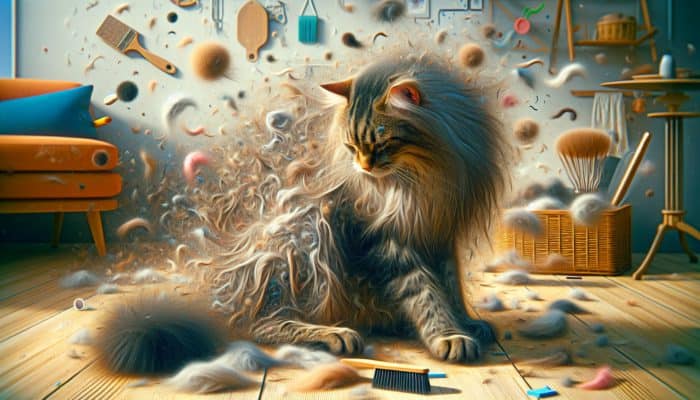Comprehensive Understanding of Hairball Formation in Felines
Identifying the Primary Factors Leading to Hairball Development in Cats

For many cat owners, managing hairballs is an ongoing concern, stemming from the natural grooming behaviours of their furry companions. As cats groom themselves, they frequently ingest loose fur, which accumulates in their digestive system over time, ultimately leading to the formation of hairballs. To effectively manage and prevent these occurrences, a thorough understanding of the various causes of hairballs is crucial. Key contributors include:
- Excessive grooming often triggered by stress or anxiety
- Long-haired breeds that tend to retain more fur
- Seasonal shedding, especially prevalent during spring and fall
- Medical conditions, such as allergies or skin issues, that result in increased grooming
By recognising these factors, cat owners can adopt proactive measures to reduce the frequency of hairballs, promoting a healthier and more comfortable life for their pets.
Cats possess unique grooming habits that function as both a cleaning method and a means of bonding with their human companions. However, an increase in grooming behaviour may indicate underlying issues that exacerbate hairball formation. For example, cats that experience anxiety or stress might engage in more frequent grooming, consequently increasing the risk of hairball development.
Understanding your cat's specific grooming behaviours is essential. Certain breeds, like the Persian and Maine Coon, are particularly susceptible to hairballs due to their long, luxurious coats. As these breeds groom themselves, they naturally ingest a greater amount of their fur. In contrast, short-haired breeds such as the Siamese or American Shorthair may encounter fewer hairball incidents, although they are not completely immune to this issue.
Exploring the Connection Between the Digestive Process and Hairball Formation
The digestive system of cats is integral to the formation of hairballs. As obligate carnivores, cats have digestive systems primarily adapted to process animal proteins. When a cat ingests fur, it travels down the esophagus and enters the stomach, where it can mix with food and other substances. If the fur is not expelled through vomiting or feces, it may clump together, resulting in a hairball.
The digestive process begins in the mouth, where a cat's teeth and saliva work in conjunction to break down food. Following this, the food moves down the esophagus and into the stomach, where it combines with gastric juices. This stage is critical for hairball formation, especially if a cat has consumed a considerable amount of fur. If the stomach struggles to manage the hairball, it may lead to vomiting or other digestive complications.
Understanding this digestive process is vital for cat owners who wish to manage hairballs effectively and identify signs of digestive distress. When hairballs become a frequent problem, it might signal that the digestive system is not functioning optimally. Observing how your cat digests food and handles hairballs can provide significant insight into their overall health and well-being.
Assessing the Frequency of Hairball Problems in Cats
The incidence of hairballs in cats can vary widely due to numerous influencing factors. On average, hairballs may appear anywhere from weekly to monthly, contingent on the cat's breed, grooming habits, and overall health. Generally, long-haired breeds are more likely to experience hairballs than their short-haired counterparts; however, additional factors such as age, stress levels, and diet also significantly impact this variability.
Younger, healthier cats may experience hairballs less frequently than older cats, who may confront more health challenges or slower digestive processes. Moreover, specific stressors, such as moving to a new home or introducing another pet, can lead to heightened grooming behaviours, subsequently resulting in increased hairball formation.
It is also crucial to note that certain seasons may contribute to a rise in hairball occurrences due to heightened shedding. For instance, during spring and fall, cats typically shed more fur, increasing the likelihood of hairball formation. Keeping a close eye on your cat’s hairball frequency can help identify patterns that may suggest underlying health issues or necessary adjustments in grooming or dietary practices.
Proven Strategies for Effective Hairball Prevention in Cats

Top Strategies for Effective Hairball Prevention
Preventing hairballs is crucial for maintaining your cat's health and overall well-being. Implementing effective prevention practices includes proactive grooming, dietary modifications, and creating a conducive environment. Regular grooming stands out as one of the most effective strategies, as it helps eliminate loose fur before it can be ingested. For example, utilising grooming tools like brushes or combs can significantly reduce shedding and limit the amount of fur that may end up in your cat's stomach.
Another successful prevention method involves adjusting your cat's diet. Foods rich in fibre can promote smoother digestion, enabling ingested hair to pass through the digestive system more effortlessly. For instance, incorporating high-quality cat food that includes natural fibre sources, such as beet pulp, can be particularly advantageous.
Numerous real-world experiences demonstrate the effectiveness of these prevention strategies. One owner of a long-haired breed noted a significant decrease in hairballs after establishing a daily grooming routine and transitioning to a diet enriched with fibre. Additionally, creating a stress-free environment can help reduce excessive grooming, thereby minimising hairball formation.
For many cat owners, combining these strategies yields the best results in managing hairballs, underscoring the importance of a holistic approach to prevention.
Understanding the Impact of Diet on Hairball Prevention
Diet plays a pivotal role in the prevention of hairballs in cats. Making appropriate nutritional choices can significantly reduce hairball formation by promoting proper digestion and minimising the accumulation of ingested fur within the gastrointestinal tract. Certain foods, particularly those high in fibre, can assist in the passage of consumed hair through the digestive system, thus lowering the likelihood of hairball development.
When selecting food aimed at preventing hairballs, consider options that include ingredients like rice bran, psyllium, or beet pulp. These components are known to promote healthy digestion and facilitate the movement of hair. Furthermore, offering wet food can also be advantageous as it enhances moisture intake, which is critical for overall digestive health.
To effectively incorporate beneficial foods into your cat's diet, begin by gradually mixing in high-fibre options with their regular food. This gradual transition helps minimise the risk of digestive upset. Observing your cat's response to these dietary changes is essential; if you notice a decrease in hairball frequency or improvements in their overall health, you’ve likely found a suitable dietary solution.
Additionally, consulting with a veterinarian for personalised dietary recommendations can significantly enhance the effectiveness of your hairball prevention strategy. They can provide tailored insights based on your cat's specific health needs and lifestyle.
The Importance of Grooming in Hairball Management

Grooming is vital for effective hairball management and should be a fundamental aspect of your cat's care routine. Regular brushing helps eliminate loose, dead fur that, if ingested, can contribute to hairball formation. Various grooming tools are available for different coat types; for instance, slicker brushes are ideal for long-haired breeds, while rubber grooming gloves work well for short-haired cats.
The frequency of grooming sessions significantly impacts their effectiveness. Ideally, long-haired cats should be groomed daily, while short-haired cats benefit from grooming at least weekly. Grooming not only reduces the amount of fur that can be ingested but also serves as a bonding experience between the cat and its owner, promoting overall well-being.
Experts recommend focusing on specific areas where cats tend to shed more, such as around the neck, belly, and tail. Concentrating on these regions during grooming can yield better results in reducing loose fur. Additionally, introducing grooming at a young age can help cats acclimatise to the process, making it easier for owners to maintain a consistent grooming schedule.
Ultimately, mastering grooming techniques can significantly lower the frequency of hairballs, contributing to a healthier and more comfortable life for your feline companion.
The Role of Hydration in Hairball Prevention
Proper hydration is essential in the battle against hairballs, as it supports overall digestive health. When cats are well-hydrated, their digestive systems function efficiently, facilitating the passage of ingested hair through the intestines. Conversely, dehydration can lead to hard, compacted stool, which may obstruct the movement of hair and other materials, increasing the risk of hairballs.
Encouraging your cat to drink more water can be accomplished through various methods. One effective approach is to provide fresh water daily and change it regularly, ensuring it remains appealing. Additionally, some cats prefer running water, making a cat water fountain a worthwhile investment to stimulate their drinking habits. Offering wet food also promotes hydration, as it contains a higher moisture content than dry kibble.
Moreover, adding a splash of low-sodium broth to the water can entice cats to drink more. Keeping a close eye on your cat's water intake is crucial; if you notice a decrease, it may be necessary to assess their environment or dietary choices.
In summary, ensuring your cat remains hydrated is a critical step in preventing hairballs and promoting a healthy digestive system. Adequate hydration is vital for your pet's overall health, and taking proactive measures to increase their water intake can lead to positive outcomes in their grooming habits and hairball management.
The Benefits of Supplements for Hairball Control
Supplements can serve as valuable tools in managing hairballs, providing additional resources to help your cat effectively pass ingested fur. Various supplements, particularly those rich in omega-3 fatty acids, fibre, or specific enzymes, can support a cat's digestive health and reduce hairball formation.
For instance, omega-3 and omega-6 fatty acids can enhance skin health and reduce shedding, thereby limiting the amount of fur that can be ingested. Fibre supplements can promote smoother passage of hair through the digestive tract, aiding overall digestion.
When considering supplements, it is imperative to select high-quality products specifically formulated for cats. Always consult with a veterinarian before introducing new supplements, as they can provide personalised recommendations tailored to your cat's specific health and dietary needs.
Integrating supplements into your cat's routine can be done gradually. You can mix them into their food or offer them as treats, ensuring they are palatable and appealing. Observing your cat's response to these supplements will help assess their effectiveness in controlling hairballs.
While supplements can be beneficial, they should be used alongside a holistic approach that includes a balanced diet, proper grooming, and adequate hydration for optimal hairball prevention.
Recognising Indicators of Hairball Issues in Cats
Identifying the Symptoms Associated with Hairball Problems
Early recognition of hairball-related issues can significantly prevent more serious complications. Common signs that your cat may be experiencing hairball problems include vomiting hairballs, lethargy, and noticeable changes in appetite. Regularly monitoring your cat for these symptoms is crucial for assessing the frequency and severity of hairball incidents.
Frequent vomiting of hairballs may suggest that your cat is ingesting more fur than they can effectively expel. Additionally, lethargy may indicate discomfort or distress caused by a hairball obstructing the digestive tract, while a notable loss of appetite can signal that your cat is unwell.
Cats may also display behaviours such as coughing or retching without producing a hairball, which could suggest that a hairball is lodged in the esophagus or stomach. It is crucial to take these signs seriously and monitor your cat for any additional symptoms that may indicate distress or health concerns.
Being vigilant about your cat's behaviour and physical symptoms can help ensure that hairball problems are addressed promptly, thus preventing potential complications and enhancing their overall well-being.
When to Seek Veterinary Assistance for Hairball Issues
Understanding when to consult a veterinarian regarding hairball-related issues is essential for your cat's health. If a cat exhibits severe symptoms such as repeated vomiting, significant lethargy, or a noticeable loss of appetite, it may be time to seek professional help. Additionally, if a cat shows signs of distress or discomfort and is unable to pass hairballs, a thorough evaluation by a veterinarian is warranted.
Cats experiencing constipation or diarrhoea, particularly if accompanied by symptoms of hairballs, should also be examined by a veterinarian. These indicators could suggest that the digestive system is not functioning properly and may require medical intervention.
Veterinarians can conduct examinations and recommend diagnostic tests, such as X-rays or ultrasounds, to identify the underlying causes of these issues. Following their recommendations can help identify and address any health problems contributing to hairball formation, ensuring your cat remains healthy and comfortable.
Proactive veterinary care is essential for effectively managing hairball problems. Recognising when to seek assistance can safeguard your cat’s health and overall well-being.
The Consequences of Ignoring Hairball Issues in Cats
Neglecting hairball problems in cats can lead to serious health complications, making it imperative to address them proactively. One of the most significant risks associated with hairballs is the potential for blockages in the digestive tract. If a hairball cannot be expelled through vomiting or feces, it can cause an obstruction, resulting in severe discomfort, pain, and potentially life-threatening situations.
Other complications may include digestive disorders, as a cat may develop issues such as constipation or diarrhoea when their system struggles to process hair. Additionally, untreated hairball concerns can lead to chronic vomiting, negatively impacting a cat's overall health and well-being.
Preventing hairball issues through regular grooming, dietary modifications, and adequate hydration can significantly mitigate these risks. Being aware of your cat's behaviour and intervening promptly can help prevent complications and ensure your cat remains healthy and active.
Recognising the importance of managing hairballs is vital for every cat owner. Failing to address this aspect of feline care can have detrimental effects on your cat’s health, making an active approach essential.
Effective Preventive Strategies for Hairball Control
Implementing preventive strategies to manage hairballs can significantly reduce the occurrence of this common issue. Regular grooming, dietary adjustments, and the use of specialised hairball control products are effective methods for minimising hairball formation.
Establishing a consistent grooming routine is critical; this practice not only helps remove loose fur but also allows you to monitor your cat's coat and skin for any abnormalities. Alongside routine grooming, adjusting your cat's diet to include hairball control formulas can enhance digestion and prevent hair accumulation in the stomach.
In addition to grooming and dietary changes, incorporating hairball control products can strengthen your prevention strategy. Look for lubricants and supplements specifically designed for hairball prevention; following the manufacturer’s guidelines for proper use is key. These products can assist in moving hair through the digestive system, significantly reducing the likelihood of hairballs forming.
By adopting a proactive approach to hairball management, you can diminish the risks associated with hairballs and promote a healthier lifestyle for your feline companion.
Research-Backed Benefits of Hairball Prevention for Cats
How Effective Hairball Prevention Enhances Digestive Health
Successfully preventing hairballs can lead to improved digestive health in cats. When hairballs are managed effectively, the occurrence of gastrointestinal blockages and related discomfort decreases. Optimal digestion enables more efficient nutrient breakdown, which is essential for overall well-being.
Key benefits of improved digestive health associated with hairball prevention include:
- Reduced risk of vomiting and regurgitation
- Healthier stool consistency
- Increased nutrient absorption
- Fewer veterinary visits for digestive issues
Cats that experience fewer hairballs often lead more comfortable lives, as they are less likely to encounter digestive distress.
Moreover, a healthy digestive system positively influences their appetite and energy levels, resulting in a more active and fulfilling lifestyle. By prioritising hairball prevention through regular grooming, dietary modifications, and hydration, cat owners can significantly enhance their pets' digestive health.
How Hairball Prevention Contributes to Overall Well-being
Preventing hairballs not only improves digestive health but also enhances a cat's overall well-being. Cats that frequently experience hairballs often display signs of discomfort, leading to behavioural changes such as increased hiding or reduced playfulness. By minimising hairball occurrences, cat owners can help their pets lead happier and more active lives.
Fewer hairball issues correlate with increased playfulness and engagement, as cats are less likely to suffer from the discomfort associated with hairballs. Additionally, a reduction in grooming-related stress can lead to a more balanced emotional state for your feline friend.
The connection between hairball prevention and overall well-being is evident. By implementing effective management strategies, cat owners can create a healthier and happier environment for their pets.
The Long-term Health Benefits of Hairball Prevention
Proactively preventing hairballs offers several significant health benefits for cats in the long run. By addressing hairball issues early, owners can reduce the risks of complications, including blockages, chronic vomiting, and general digestive problems. These benefits contribute to a markedly improved quality of life for cats.
One notable long-term benefit is a decreased risk of gastrointestinal obstructions. When hairballs are infrequent, the digestive system can function more efficiently, leading to better nutrient absorption and less strain on the body.
Furthermore, cats with fewer hairballs are less likely to develop chronic health problems related to digestive distress. A healthier cat typically enjoys a longer lifespan and faces fewer illnesses stemming from neglecting hairball management.
In essence, prioritising long-term hairball prevention can lead to a more fulfilling life for cats, enhancing their health and happiness while reducing the need for extensive veterinary care.
Implementing Comprehensive Hairball Prevention Strategies
How to Establish a Daily Grooming Routine for Your Cat
Creating a daily grooming schedule is vital for effective hairball prevention. Consistency in grooming not only helps reduce the amount of loose fur that can be ingested but also strengthens the bond between you and your cat. Start by selecting a time of day that suits both you and your feline friend, ensuring a calm environment that encourages cooperation during grooming sessions.
For long-haired cats, daily grooming is essential. While it may take only a few minutes each day, this practice can ultimately save you from dealing with frequent hairballs. Short-haired cats benefit from grooming sessions two to three times a week, focusing on areas where they tend to shed the most, such as the belly and the back of the ears.
Incorporating check-ins during grooming sessions is also beneficial. Use this time to observe your cat's skin for any abnormalities or signs of discomfort. This proactive measure can help catch potential problems early, allowing for timely veterinary intervention if necessary.
Establishing a grooming routine not only aids in hairball prevention but also promotes your cat's overall health and well-being.
Essential Components of a Hairball Prevention Diet
A diet designed for hairball prevention should be rich in specific nutrients that aid digestion and reduce hairball formation. High-fibre foods are crucial, as they facilitate the passage of hair through the digestive system. Ingredients such as beet pulp, pumpkin, and rice bran provide the essential fibre needed for proper digestion.
In addition, incorporating wet food into your cat’s diet can also be advantageous, as it increases moisture intake and supports overall digestive health. Look for high-quality cat food formulations designed for hairball control, as these typically contain the right balance of nutrients to promote healthy digestion.
To ensure that your cat's diet effectively supports hairball prevention, gradually mix these beneficial foods into their regular meals. Monitoring their response will help you gauge the effectiveness of dietary changes. Consulting with a veterinarian can provide personalised guidance on the best dietary practices for your cat's unique needs.
Overall, a well-rounded hairball prevention diet will lead to a healthier and more comfortable cat, significantly reducing the occurrence of hairball issues.
Importance of Monitoring and Adjusting the Hairball Prevention Routine
Monitoring and adjusting your hairball prevention routine is essential for its ongoing success. Regularly observing your cat's grooming habits, dietary responses, and overall well-being can provide valuable insights into the effectiveness of your current strategy.
If you notice an increase in hairball occurrences, it may indicate that adjustments are needed within the grooming schedule, diet, or hydration strategies. For instance, if your cat continues to experience hairballs despite regular grooming, it may be necessary to evaluate their diet and incorporate more fibre-rich options or consult with a veterinarian for targeted advice.
Keeping a journal to document grooming sessions, dietary changes, and any observed symptoms can also be beneficial. This recorded information can help identify patterns and provide a clearer picture of what strategies work best for your cat.
Ultimately, being proactive about adjusting your hairball prevention routine can lead to lasting improvements in your cat’s health and comfort.
How to Effectively Utilise Hairball Control Products
Incorporating hairball control products into your cat's prevention strategy can significantly enhance the management of hairball issues. These products come in various forms, including lubricants, treats, and supplements specifically designed to aid digestion and facilitate the passage of hair through the system more easily.
When selecting hairball control products, it is essential to choose those specifically formulated for cats and to follow the manufacturer’s usage instructions carefully. Begin by gradually introducing these products into your cat's routine, ensuring they find them appealing.
Monitoring your cat's response to these products can help gauge their effectiveness. If you notice a reduction in hairball occurrences or improvements in overall well-being, you’ve likely found a suitable addition to your prevention strategy.
Overall, utilising hairball control products, alongside a comprehensive grooming and dietary plan, can lead to a markedly healthier and more comfortable life for your feline friend.
The Importance of Regular Veterinary Check-ups for Hairball Management
Scheduling regular veterinary check-ups is essential for effectively managing hairball issues. These check-ups not only help maintain your cat's overall health but also provide an opportunity to discuss any concerns related to hairballs. Veterinarians can offer personalised advice tailored to your cat’s specific needs, including recommendations for grooming, diet, and preventive measures.
During these visits, your veterinarian can conduct thorough assessments and any necessary diagnostic tests to ensure your cat’s health is optimal. This proactive approach can lead to early detection of potential health issues, which can be addressed promptly, thus preventing complications associated with hairballs.
Discussing the effectiveness of your current hairball management strategies during vet visits allows for timely adjustments based on professional insights.
In conclusion, regular veterinary check-ups are a vital component of a comprehensive hairball prevention strategy, ensuring that your cat remains healthy and comfortable throughout their life.
Frequently Asked Questions Regarding Hairball Problems in Cats
What Exactly Are Hairballs in Cats?
Hairballs are clumps of fur that form in a cat's stomach due to excessive grooming. They can be expelled through vomiting or feces and may cause discomfort or health issues if not managed appropriately.
How Often Should I Groom My Cat to Minimise Hairballs?
Long-haired cats should be groomed daily, while short-haired cats can be groomed 2-3 times a week. Regular grooming helps remove loose fur and significantly reduces hairball formation.
Can Diet Truly Influence Hairball Development?
Yes, a diet high in fibre can facilitate digestion and assist hair in passing through the system more easily, thereby reducing the likelihood of hairball formation.
What Signs Indicate My Cat May Have a Hairball Issue?
Common signs include vomiting hairballs, lethargy, loss of appetite, or coughing without producing a hairball. Monitoring these symptoms can help identify issues early and take appropriate action.
When Should I Consult a Veterinarian About Hairballs?
If your cat exhibits severe symptoms such as repeated vomiting, notable lethargy, or an inability to pass hairballs, it is advisable to consult a veterinarian for a thorough evaluation.
Are There Specific Grooming Techniques That Can Assist?
Yes, using the appropriate grooming tools based on your cat’s coat type and establishing a consistent grooming schedule are key strategies for effectively preventing hairballs.
How Does Hydration Relate to Hairball Prevention?
Proper hydration promotes healthy digestion, helping to prevent hair from accumulating in the stomach and reducing the likelihood of hairballs forming.
What Supplements Can Support Hairball Management?
Supplements containing omega fatty acids, fibre, or specific enzymes can aid hairball management by enhancing digestion and reducing hair accumulation within the gastrointestinal tract.
Can I Use Store-Bought Hairball Remedies?
Yes, many store-bought hairball remedies are effective. However, it is essential to choose high-quality products specifically formulated for cats and consult your veterinarian for personalised recommendations based on your cat's individual needs.
What Are the Long-Term Health Benefits of Preventing Hairballs?
Long-term hairball prevention can reduce the risk of gastrointestinal blockages, improve overall digestive health, and enhance your cat's quality of life, ultimately contributing to a longer lifespan.
Connect with us on Facebook!
The Article Hairball Prevention for Cats: Essential Tips First Published On https://elgatoencasa.com
The Article Hairball Prevention Tips for Cats: Essential Guide Was Found On https://limitsofstrategy.com


